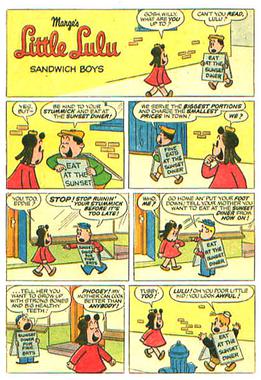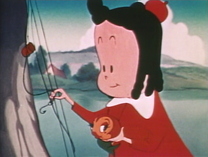Little Lulu is a comic strip created in 1935 by American author Marjorie Henderson Buell.[1] The character, Lulu Moppet, debuted in The Saturday Evening Post on February 23, 1935, in a single panel, appearing as a flower girl at a wedding and mischievously strewing the aisle with banana peels. Little Lulu replaced Carl Anderson‘s Henry, which had been picked up for distribution by King Features Syndicate. The Little Lulu panel continued to run weekly in The Saturday Evening Post until December 30, 1944.
Little Lulu was created as a result of Anderson’s success. Schlesinger Library curator Kathryn Allamong Jacob wrote:Lulu was born in 1935, when The Saturday Evening Post asked Buell to create a successor to the magazine’s Henry, Carl Anderson’s stout, mute little boy, who was moving on to national syndication. The result was Little Lulu, the resourceful, equally silent (at first) little girl whose loopy curls were reminiscent of the artist’s own as a girl. Buell explained to a reporter, “I wanted a girl because a girl could get away with more fresh stunts that in a small boy would seem boorish”.[2]
History[edit]
| Marge’s Little Lulu | |
|---|---|
| Publication information | |
| Publisher | Dell/Gold Key(Western) |
| Schedule | bi-monthly |
| Format | Ongoing series |
| Genre | Humor/comedy |
| Publication date | Jan/Feb 1948 – March 1984 |
| No. of issues | 268 |
| Creative team | |
| Written by | John Stanley |
| Artist(s) | Irving Tripp John Stanley |
| Collected editions | |
| In the Doghouse | ISBN 1-59307-345-3 |
| Lulu Goes Shopping | ISBN 1-59307-270-8 |
| Lulu Takes a Trip | ISBN 1-59307-317-8 |
| Letters to Santa | ISBN 1-59307-386-0 |
| Lulu’s Umbrella Service | ISBN 1-59307-399-2 |
Marjorie Henderson Buell (1904–1993), whose work appeared under the pen name “Marge”, had created two comic strips in the 1920s: The Boy Friend and Dashing Dot, both with female leads. She first had Little Lulu published as a single-panel cartoon in The Saturday Evening Post on February 23, 1935. The single-panel strip continued in the Post until the December 30, 1944 issue, and continued from then as a regular comic strip.[3] Buell herself ceased drawing the comic strip in 1947. In 1950, Little Lulu became a daily syndicated series by Chicago Tribune–New York News Syndicate, and ran until 1969.[4]
Comic-book stories of the character scripted by John Stanley appeared in ten issues of Dell’s Four Color before a Marge’s Little Lulu series appeared in 1948 with scripts and layouts by Stanley and finished art by Irving Tripp and others.[5] Stanley greatly expanded the cast of characters and changed the name of Lulu’s portly pal from “Joe” to “Tubby“, a character that was popular enough himself to warrant a Marge’s Tubby series that ran from 1952 to 1961.[3] Little Lulu was widely merchandised,[6] Writer/artist John Stanley‘s work on the Little Lulu comic book is highly regarded. He did the initial Lulu comics, later working with artists Irving Tripp and Charles Hedinger (Tripp inking Hedinger before eventually assuming both duties),[7] writing and laying out the stories.
He continued working on the comic until around 1959. Stanley is responsible for the many additional characters in the stories. After Stanley, other writers produced the Lulu stories for Gold Key Comics, including Arnold Drake. The comics were translated into French, Spanish, Japanese, Arabic, Portuguese, and other languages.[6] After Buell’s retirement in 1972[4] she signed the rights to Western Publishing.[8] Marge’s was dropped from the title,[4] and the series continued until 1984.[3]
Characters[edit]
Main article: List of Little Lulu characters
The main characters of the Little Lulu comic strip include the following.[9] Full details and supporting and minor characters can be found in the main article of Little Lulu characters. Variations from the comic strip and other media representations are discussed in the main article.
- Little Lulu – Louise “Little Lulu” Moppet is the main character and Tubby and Annie’s best friend. She is very smart, but stubborn and always initiates a battle with the boys to show that the girls are as good as them. Lulu is also very creative and tells stories to Alvin to teach him a lesson with fun. She wears a red dress and hat and has long black curly hair with brown highlights.
- Tubby Tompkins – Theodore “Tubby” Tompkins is Lulu’s male best friend and her chief opponent in their disputes. He is the leader of the boys’ club known as “The Fellers”. He is relapsed and always forgets to pay the monthly fee or to fulfill the obligations and his clubmates often take him out of office. Tubby is in love with Gloria, but she’s rarely given him a chance. He has red hair and wears a white sailor hat, a black suit jacket, a large blue bow tie and light brown/orange pants, making his attire very similar to a sailor’s uniform. See main article: Tubby Tompkins.
- Annie Inch – Lulu’s female best friend who is involved in most of Lulu’s escapades and adventures. She is not as smart, but she is a true friend who helps Lulu in her plans. Sometimes she is annoyed at everyone for no reason. Annie is Iggy’s sister. She has short black straight hair and wears a blue dress (in the earlier years she wore a yellow dress).
- Iggy Inch – Tubby’s male best friend and a member of the “Fellers”. He is grumpy, mischievous and always doing tricks. Iggy is Annie’s brother. He has a shaved head, and wears a white collar shirt and orange pants (in the early years, he wore an orange collared shirt and blue pants).
- Willie Wilkins – One of Tubby’s friends and the strongest member of the “Fellers”. He has short black hair and wears an orange cap, a green suit jacket, and orange knickers (in the early years, he wore a brown cap, a red shirt and gray knickers).
- Eddie Stimson – One of Tubby’s friends and the smartest member of the “Fellers”. He often creates the boys’ plans against the West Side Boys.
- Wilbur Van Snobbe – The richest and most charming boy in town. He likes to be loved by the girls, but he is arrogant and petulant, being sweet only with Gloria. Wilbur has no friends, although he sometimes plays with the other kids. He has curly blond hair and wears a purple suit (in the early years, he had red hair and a blue suit).
- Gloria Goode – The most beautiful girl in town. She is nice and playful with the girls, who secretly hate her out of envy, and the boys, who fall in love with her. Gloria has a friendly rivalry with Lulu and she is richer than most of the class, although less than Wilbur. She has long, wavy blonde hair and wears a ruffled pink dress.
- Alvin Jones – Lulu’s 6-year-old neighbor. He is mischievous, bratty and only stops tantrums when Lulu tells a story. He has red hair with a quiff and wears a white shirt and blue overalls.
- Martha and George Moppet – Lulu’s parents. Martha is a great cook and George is always targeted by Tubby’s pursuit as a detective.
- Ellie and Jim Tompkins – Tubby’s parents.
- The West Side Boys – A gang of stronger, tougher bully boys from across town who are the rival club of the “Fellers” and always try to invade their club. The most frequently seen of the West Side Boys are Butch (the leader), Mickey and Spike, while other individual members include Mike, Slug, Junior and Guggy.
Comic strips and comic books[edit]

A daily comic strip, entitled Little Lulu, was syndicated by the Chicago Tribune-New York News Syndicate from June 5, 1950, through May 31, 1969.[10] Artists included Woody Kimbrell (1950–1964), Roger Armstrong (1964–1966), and Ed Nofziger (1966–1969).
Little Lulu appeared in ten issues of Dell Comics‘ Four Color comic book series (#74, 97, 110, 115, 120, 131, 139, 146, 158, 165), before graduating to her own title: Marge’s Little Lulu in 1948.[11]
With the Dell Comics/Western Publishing split that created Gold Key Comics, Little Lulu went to Gold Key with issue No. 165. Tubby got his own comic series from 1952 to 1961, first appearing in Four Color No. 381, 430, 444, and #461;[12] then his own title Marge’s Tubby from No. 5 thru 49. In this series, Tubby had his own adventures without Lulu, especially with the Little Men from Mars.
Upon retirement, Marge sold Little Lulu to Western Publishing. The comic was re–named Little Lulu with No. 207 (September 1972). Publication of the comics ceased in 1984 (with issue No. 268, the last few under the Whitman Comics name), when Western discontinued publishing comics. Artist Hy Eisman retained stories intended for #269–270 (scripted by Paul Kuhn) because the artwork was returned to him after the comic was cancelled. Three of these are to be reprinted in the Lulu fanzine The HoLLywood Eclectern (HE). “The Case of the Disappearing Tutu”, slated to be the lead story in Little Lulu No. 270, appears in HE No. 47 (2008).
There were also two giant-sized Annuals (#1–2, 1953–1954), 14 Dell Giants (with seasonal and other themes), a regular-sized unnumbered special on visiting Japan and three Gold Key Specials (two with Lulu on Halloween and summer camp and one with Tubby and the Little Men from Mars). Lulu also appeared in 20 issues of March of Comics and was reprinted in several Golden Comics Digests.
Between 1985 and 1992 Another Rainbow Publishing published a hardbound 18-volume set, the Little Lulu Library, collecting the stories in the Four Color issues, plus the regular series through No. 87.
While Western Publishing’s Little Lulu stopped being released in 1984, in Brazil new Lulu stories, penned by local artists, kept being published by Editora Abril.[13] Primaggio Mantovi was responsible for overseeing the production.[14] Luluzinha, Abril’s main monthly Lulu comic series, ended in 1993.[15]
Advertising and merchandising[edit]
Little Lulu was featured on numerous licensed products, and she was the centerpiece of an extensive advertising campaign for Kleenex tissues during the 1940s–50s, [16] being the first mascot for Kleenex tissues;[3] from 1952 to 1965 the character appeared in an elaborate animated billboard in Times Square in New York City.[17] and she was also seen in Pepsi-Cola magazine ads during that period.[16] Kleenex commercials featuring Little Lulu were regularly seen in the 1950s on Perry Como‘s TV show.[18] Buell (the comics’ creator) played an active role in merchandising Little Lulu, often taking a hands-on role in terms and negotiations.[19] Currently, the trademarks on Little Lulu are held by NBCUniversal (which manages the properties of DreamWorks Classics, as well as its parent company, DreamWorks Animation).[20]
Adaptations[edit]
Short films[edit]

Between 1943 and 1948, Lulu appeared in 26 theatrical animated shorts produced by Famous Studios for Paramount Pictures, replacing the Superman shorts of the 1940s.[21] Paramount went on to create a similar character, Little Audrey, after failing to renew the Lulu license (and therefore avoiding the payment of royalty fees).[22]
Lulu was voiced by Cecil Roy,[23] while Tubby was voiced by Arnold Stang.[24] The theme song for the shorts was written and composed by Buddy Kaye, Fred Wise, and Sidney Lippman, and performed by the singing group Helen Carroll and the Satisfiers. All musical arrangements were done by Winston Sharples and Sammy Timberg.[25]
